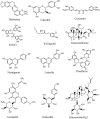Anti-ageing active ingredients from herbs and nutraceuticals used in traditional Chinese medicine: pharmacological mechanisms and implications for drug discovery
- PMID: 27659301
- PMCID: PMC5429334
- DOI: 10.1111/bph.13631
Anti-ageing active ingredients from herbs and nutraceuticals used in traditional Chinese medicine: pharmacological mechanisms and implications for drug discovery
Abstract
Ageing, an unanswered question in the medical field, is a multifactorial process that results in a progressive functional decline in cells, tissues and organisms. Although it is impossible to prevent ageing, slowing down the rate of ageing is entirely possible to achieve. Traditional Chinese medicine (TCM) is characterized by the nourishing of life and its role in anti-ageing is getting more and more attention. This article summarizes the work done on the natural products from TCM that are reported to have anti-ageing effects, in the past two decades. The effective anti-ageing ingredients identified can be generally divided into flavonoids, saponins, polysaccharides, alkaloids and others. Astragaloside, Cistanche tubulosa acteoside, icariin, tetrahydrocurcumin, quercetin, butein, berberine, catechin, curcumin, epigallocatechin gallate, gastrodin, 6-Gingerol, glaucarubinone, ginsenoside Rg1, luteolin, icarisid II, naringenin, resveratrol, theaflavin, carnosic acid, catalpol, chrysophanol, cycloastragenol, emodin, galangin, echinacoside, ferulic acid, huperzine, honokiol, isoliensinine, phycocyanin, proanthocyanidins, rosmarinic acid, oxymatrine, piceid, puerarin and salvianolic acid B are specified in this review. Simultaneously, chemical structures of the monomers with anti-ageing activities are listed, and their source, model, efficacy and mechanism are also described. The TCMs with anti-ageing function are classified according to their action pathways, including the telomere and telomerase, the sirtuins, the mammalian target of rapamycin, AMP-activated kinase and insulin/insulin-like growth factor-1 signalling pathway, free radicals scavenging and the resistance to DNA damage. Finally, Chinese compound prescription and extracts related to anti-ageing are introduced, which provides the basis and the direction for the further development of novel and potential drugs.
Linked articles: This article is part of a themed section on Principles of Pharmacological Research of Nutraceuticals. To view the other articles in this section visit http://onlinelibrary.wiley.com/doi/10.1111/bph.v174.11/issuetoc.
© 2016 The British Pharmacological Society.
Figures





Similar articles
-
Antidepressant active ingredients from herbs and nutraceuticals used in TCM: pharmacological mechanisms and prospects for drug discovery.Pharmacol Res. 2019 Dec;150:104520. doi: 10.1016/j.phrs.2019.104520. Epub 2019 Nov 6. Pharmacol Res. 2019. PMID: 31706012 Review.
-
Traditional Chinese medicine formulas for the treatment of osteoporosis: Implication for antiosteoporotic drug discovery.J Ethnopharmacol. 2016 Aug 2;189:61-80. doi: 10.1016/j.jep.2016.05.025. Epub 2016 May 11. J Ethnopharmacol. 2016. PMID: 27180315 Review.
-
Natural bioactive constituents from herbs and nutraceuticals promote browning of white adipose tissue.Pharmacol Res. 2022 Apr;178:106175. doi: 10.1016/j.phrs.2022.106175. Epub 2022 Mar 10. Pharmacol Res. 2022. PMID: 35283301
-
Traditional Chinese medicine: a treasured natural resource of anticancer drug research and development.Am J Chin Med. 2014;42(3):543-59. doi: 10.1142/S0192415X14500359. Am J Chin Med. 2014. PMID: 24871650 Review.
-
Chinese herbal medicines: The modulator of nonalcoholic fatty liver disease targeting oxidative stress.J Ethnopharmacol. 2024 Jan 10;318(Pt B):116927. doi: 10.1016/j.jep.2023.116927. Epub 2023 Jul 31. J Ethnopharmacol. 2024. PMID: 37532073 Review.
Cited by
-
Asymmetric total synthesis of (1S,2S,4S)-β-elemene.RSC Adv. 2022 Mar 15;12(13):8249-8255. doi: 10.1039/d2ra01408d. eCollection 2022 Mar 8. RSC Adv. 2022. PMID: 35424753 Free PMC article.
-
Hyperoside attenuates renal aging and injury induced by D-galactose via inhibiting AMPK-ULK1 signaling-mediated autophagy.Aging (Albany NY). 2018 Dec 24;10(12):4197-4212. doi: 10.18632/aging.101723. Aging (Albany NY). 2018. PMID: 30585174 Free PMC article.
-
Procyanidin B2 inhibits lipopolysaccharide‑induced apoptosis by suppressing the Bcl‑2/Bax and NF‑κB signalling pathways in human umbilical vein endothelial cells.Mol Med Rep. 2021 Apr;23(4):267. doi: 10.3892/mmr.2021.11906. Epub 2021 Feb 12. Mol Med Rep. 2021. PMID: 33576443 Free PMC article.
-
Review of the Efficacy and Mechanisms of Traditional Chinese Medicines as a Therapeutic Option for Ionizing Radiation Induced Damage.Front Pharmacol. 2021 Feb 15;12:617559. doi: 10.3389/fphar.2021.617559. eCollection 2021. Front Pharmacol. 2021. PMID: 33658941 Free PMC article. Review.
-
Chrysophanol Attenuates Manifestations of Immune Bowel Diseases by Regulation of Colorectal Cells and T Cells Activation In Vivo.Molecules. 2021 Mar 17;26(6):1682. doi: 10.3390/molecules26061682. Molecules. 2021. PMID: 33802855 Free PMC article.
References
-
- Allsopp RC, Harley CB (1995). Evidence for a critical telomere length in senescent human fibroblasts. Exp Cell Res 219: 130–136. - PubMed
Publication types
MeSH terms
Substances
LinkOut - more resources
Full Text Sources
Other Literature Sources
Medical
Miscellaneous

